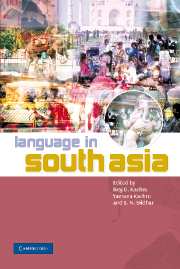Book contents
- Frontmatter
- Contents
- List of Figures
- List of Maps
- List of Tables
- Preface
- Acknowledgments
- List of Abbreviations
- Note on Transcription
- Introduction: languages, contexts, and constructs
- Part 1 Language history, families, and typology
- Part 2 Languages and their functions
- 3 Hindi–Urdu–Hindustani
- 4 Persian in South Asia
- 5 Major regional languages
- 6 Minority languages and their status
- 7 Tribal languages
- Part 3 Sanskrit and traditions of language study
- Part 4 Multilingualism, contact, and convergence
- Part 5 Orality, literacy, and writing systems
- Part 6 Language conflicts
- Part 7 Language and modernization
- Part 8 Language and discourse
- Part 9 Language and identity
- Part 10 Languages in diaspora
- References
- Subject Index
- Language Index
- Author Index
7 - Tribal languages
Published online by Cambridge University Press: 04 May 2010
- Frontmatter
- Contents
- List of Figures
- List of Maps
- List of Tables
- Preface
- Acknowledgments
- List of Abbreviations
- Note on Transcription
- Introduction: languages, contexts, and constructs
- Part 1 Language history, families, and typology
- Part 2 Languages and their functions
- 3 Hindi–Urdu–Hindustani
- 4 Persian in South Asia
- 5 Major regional languages
- 6 Minority languages and their status
- 7 Tribal languages
- Part 3 Sanskrit and traditions of language study
- Part 4 Multilingualism, contact, and convergence
- Part 5 Orality, literacy, and writing systems
- Part 6 Language conflicts
- Part 7 Language and modernization
- Part 8 Language and discourse
- Part 9 Language and identity
- Part 10 Languages in diaspora
- References
- Subject Index
- Language Index
- Author Index
Summary
Introduction
It is an extremely difficult task to define what is a tribe or who is a tribal. The term “tribe” has been used since the British rulers introduced it in 1872 to describe a few select communities in India. A year earlier in 1871 they had identified supposedly “criminal” tribes by an act. This act was repealed by the Government of India in 1952, thereby denotifying these tribes. Ironically, denotifying the tribes has not removed the stigma attached to these communities, as Denotified Tribes (DNT) are still considered “criminal tribes.”
Tribes or Adivasis in India, whether DNT or not, do not form a neat, homogenous sociocultural category. No one can demarcate a clear divide between the tribal and the nontribal in India. Yet “tribe” in India is a significant reality, characterized by a distinct way of life, rather than by virtue of forming a constituent part of the hierarchical structure of society as in the rest of India. They are outside the “caste,” or “jati” system.
The term “tribe” is thus employed by the Constitution of India to refer to certain communities. These tribes are “scheduled” as per Article 342 of the Constitution by the President and the parliament. The concept of tribe in India is an administrative, judicial, and political concept, which is applied to sections of the population that are relatively isolated.
- Type
- Chapter
- Information
- Language in South Asia , pp. 153 - 174Publisher: Cambridge University PressPrint publication year: 2008
- 6
- Cited by



